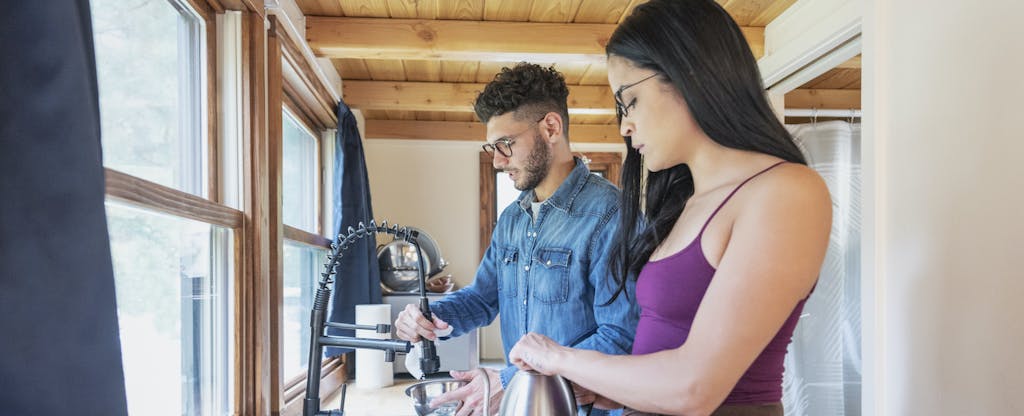In a Nutshell
If you want to downsize or simplify your financial life, a tiny home might sound appealing to you. But if you’re not ready to pay for the entire home in cash, you might be considering tiny-home financing. We’ll review three options — outside of a mortgage — for you to consider.If you’re looking to ditch the square footage, you may be considering tiny-house living.
You’re not alone. In fact, 53% of people surveyed in a 2018 National Association of Home Builders survey said they would consider living in a tiny home, which the NAHB defines as a home that’s less than 600 square feet.
Living small may save you big bucks, but building a tiny house isn’t free. It can cost anywhere from $8,000 for the tiniest of homes all the way up to $150,000 for more luxurious models. Even though that might seem more affordable than a traditional home, getting traditional mortgage financing for a tiny home could be tougher than getting a mortgage for a more traditional home.
If you’ve decided you’re ready for the tiny-house lifestyle, you have a few other financing options to consider. Keep reading to see which type of tiny-home financing might make sense for you.
What kind of loan can I get for a tiny house?
Even though a tiny house can cost less than the average U.S. home, you may still decide to pursue financing. Depending on how much you want to borrow, a mortgage may not be a feasible option for you. According to a 2019 Wall Street Journal article, mortgage lenders have been shying away from offering small mortgages that might suit tiny-home buyers in recent years.
But there’s some good news: If you want to pursue tiny-home financing, you have a few options outside of a mortgage. Here’s what you should know about each.
HELOC vs. home equity loan: Which is best for me?1. Personal loans
A personal loan may suit your tiny-home financing needs if you can get your hands on a competitive rate.
Like mortgages, personal loans are a type of installment loan that you pay off over a set period of time. But unlike mortgages, many personal loans are unsecured loans, which means you won’t have to put up collateral (such as your house) to take out a loan.
Some personal loan lenders even advertise tiny-home financing as a potential way to use a loan. You can start your search by comparing banks, credit unions and online lenders that offer personal loans.
Lenders will typically evaluate factors like your credit scores, credit history, income and employment status to determine if you qualify for a loan or the rates you may qualify for.
Personal loans tend to have higher interest rates than mortgages, as well as shorter loan terms. You’ll typically have 15 years to 30 years to repay a mortgage. But personal loans generally have shorter repayment terms, ranging from just a few months to seven years or more.
2. Financing from tiny-home builders
Some tiny-home builders offer financing, or they can connect you to a partner lender. If you go this route, be sure to review the loan term and interest rate the builder is offering, as well as whether the loan will be secured using the tiny home as collateral.
Try to shop around and compare loan terms since offers may differ greatly between lenders. For example, online lender LightStream offers personal loan repayment terms that range from two to seven years. Meanwhile, tiny-home builder Tiny Heirloom offers terms ranging from 15 years to 20 years.
3. HELOC or home equity loan
If you’re already a homeowner, a home equity loan or home equity line of credit (HELOC) can allow you to borrow against your current home’s equity, using your home as collateral. Your equity is determined by your home’s current value minus what you still owe on your mortgage.
This option may only make sense if you’re thinking about building a tiny home on a second property or adding a tiny home as another structure on your current property.
But there are downsides to this type of financing. If you default on your home equity loan, the lender may foreclose on the home you borrowed against, and you might lose the means to build or purchase your tiny home.
When you take out a home equity loan, you receive the money in one lump sum. This type of loan typically has a fixed interest rate that will remain the same throughout the life of the loan.
Should I finance a tiny home?
Whether you decide to finance a tiny home depends on your financial situation. Before you make a decision, it’s a good idea to look carefully at your current finances and future goals.
Before you finance a tiny home, consider asking yourself these questions.
- Can I wait a little bit longer to make this purchase and pay cash?
- What loan amount do I need?
- Do I have property to build my tiny house on?
- Will my tiny house be on wheels? (You may be able to apply for an RV loan if it is.)
- If it is on wheels, where will I store it?
- Do I have collateral to back up my loan?
- Will I need a down payment?
- What monthly payment can I afford?
- Can I pay back my loan early without facing a prepayment penalty?
- Does my financing need to cover land expenses?
- Does my financing need to cover renovation or maintenance costs?
What’s next?
Before you apply for tiny-home financing, you should research any options that may be a good fit for you. Be realistic about what type of tiny home and financing you can afford.
If you pursue tiny-home financing, take your time to shop around for the best deals. Compare each lender and take note of who is offering the best fees and interest rates before you make any final decisions.
*Approval Odds are not a guarantee of approval. Credit Karma determines Approval Odds by comparing your credit profile to other Credit Karma members who were approved for the personal loan, or whether you meet certain criteria determined by the lender. Of course, there’s no such thing as a sure thing, but knowing your Approval Odds may help you narrow down your choices. For example, you may not be approved because you don’t meet the lender’s “ability to pay standard” after they verify your income and employment; or, you already have the maximum number of accounts with that specific lender.



